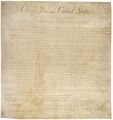Template:Selected anniversaries/September 25: Difference between revisions
No edit summary |
No edit summary |
||
| Line 11: | Line 11: | ||
||1866 – Thomas Hunt Morgan, American biologist, geneticist, and embryologist, Nobel Prize laureate (d. 1945) | ||1866 – Thomas Hunt Morgan, American biologist, geneticist, and embryologist, Nobel Prize laureate (d. 1945) | ||
||1893 | File:Harald Cramér.jpg|link=Harald Cramér (nonfiction)|1893: Mathematician and statistician [[Harald Cramér (nonfiction)|Harald Cramér]] born. He will help found probability theory as a branch of mathematics, writing in 1926: "The probability concept should be introduced by a purely mathematical definition, from which its fundamental properties and the classical theorems are deduced by purely mathematical operations." | ||
In the late 1920s, Cramér became interested in the field of probability, which at the time was not an accepted branch of mathematics. Cramér knew that a radical change was needed in this field, and | |||
||1906 – In the presence of the king and before a great crowd, Leonardo Torres y Quevedo successfully demonstrates the invention of the Telekino in the port of Bilbao, guiding a boat from the shore, in what is considered the birth of the remote control. | ||1906 – In the presence of the king and before a great crowd, Leonardo Torres y Quevedo successfully demonstrates the invention of the Telekino in the port of Bilbao, guiding a boat from the shore, in what is considered the birth of the remote control. | ||
| Line 31: | Line 34: | ||
File:George Plimpton 1993.jpg|link=George Plimpton (nonfiction)|2003: Journalist, writer, literary editor, and actor [[George Plimpton (nonfiction)|George Plimpton]] dies. | File:George Plimpton 1993.jpg|link=George Plimpton (nonfiction)|2003: Journalist, writer, literary editor, and actor [[George Plimpton (nonfiction)|George Plimpton]] dies. | ||
File:Gordon Gould.jpg|link=Gordon Gould (nonfiction)|2004: Physicist and crime-fighter [[Gordon Gould (nonfiction)|Gordon Gould]] demonstrates new type of quantum laser which detects and isolates [[crimes against mathematical constants]]. | |File:Gordon Gould.jpg|link=Gordon Gould (nonfiction)|2004: Physicist and crime-fighter [[Gordon Gould (nonfiction)|Gordon Gould]] demonstrates new type of quantum laser which detects and isolates [[crimes against mathematical constants]]. | ||
|File:Egg Tooth Neighborhood Association logo.jpg|link=Egg Tooth (neighborhood)|[[Egg Tooth (neighborhood)|Egg Tooth Neighborhood Association]] honors life and work of [[George Plimpton (nonfiction)|George Plimpton]]. | |File:Egg Tooth Neighborhood Association logo.jpg|link=Egg Tooth (neighborhood)|[[Egg Tooth (neighborhood)|Egg Tooth Neighborhood Association]] honors life and work of [[George Plimpton (nonfiction)|George Plimpton]]. | ||
</gallery> | </gallery> | ||
Revision as of 09:51, 4 September 2017
1644: Astronomer and instrument maker Ole Rømer born. He will make the first quantitative measurements of the speed of light.
1789: The United States Congress passes twelve amendments to the United States Constitution: The Congressional Apportionment Amendment (which was never ratified), the Congressional Compensation Amendment, and the ten that are known as the Bill of Rights.
1845: Judge Havelock With Glass is "a reasonably accurate depiction of events as I experienced them," according to the Judge.
1893: Mathematician and statistician Harald Cramér born. He will help found probability theory as a branch of mathematics, writing in 1926: "The probability concept should be introduced by a purely mathematical definition, from which its fundamental properties and the classical theorems are deduced by purely mathematical operations."
- In the late 1920s, Cramér became interested in the field of probability, which at the time was not an accepted branch of mathematics. Cramér knew that a radical change was needed in this field, and
2003: Journalist, writer, literary editor, and actor George Plimpton dies.




